The exhibition Roberto Burle Marx: Brazilian Modernist at New York City’s Jewish Museum seeks to present this renowned landscape architect as much more than that, examining the wealth and range of his artistic production including paintings, drawings, sculptural follies, jewelry, stage sets, costumes, glassworks, and a gorgeous 90-foot-wide tapestry, alongside his extraordinary gouache garden plans and planting lists for several of his public and private gardens. The show—curated by Jens Hoffmann and Claudia J. Nahson and on view from May 6 through September 18, 2016, and elegantly designed by Galia Solomonoff—follows on the heels of a similar exhibition held at the Pinacoteca do Estado de São Paulo in 2014–2015 titled Roberto Burle Marx: Uma Vontade de Beleza, curated by Giancarlo Hannud, likewise focused on an assessment and appreciation of Burle Marx’s artistic practice beyond the landscape. Of course, any presentation of gardens and parks is difficult to exhibit within the realm of the gallery; the object-work is simply easier to show.
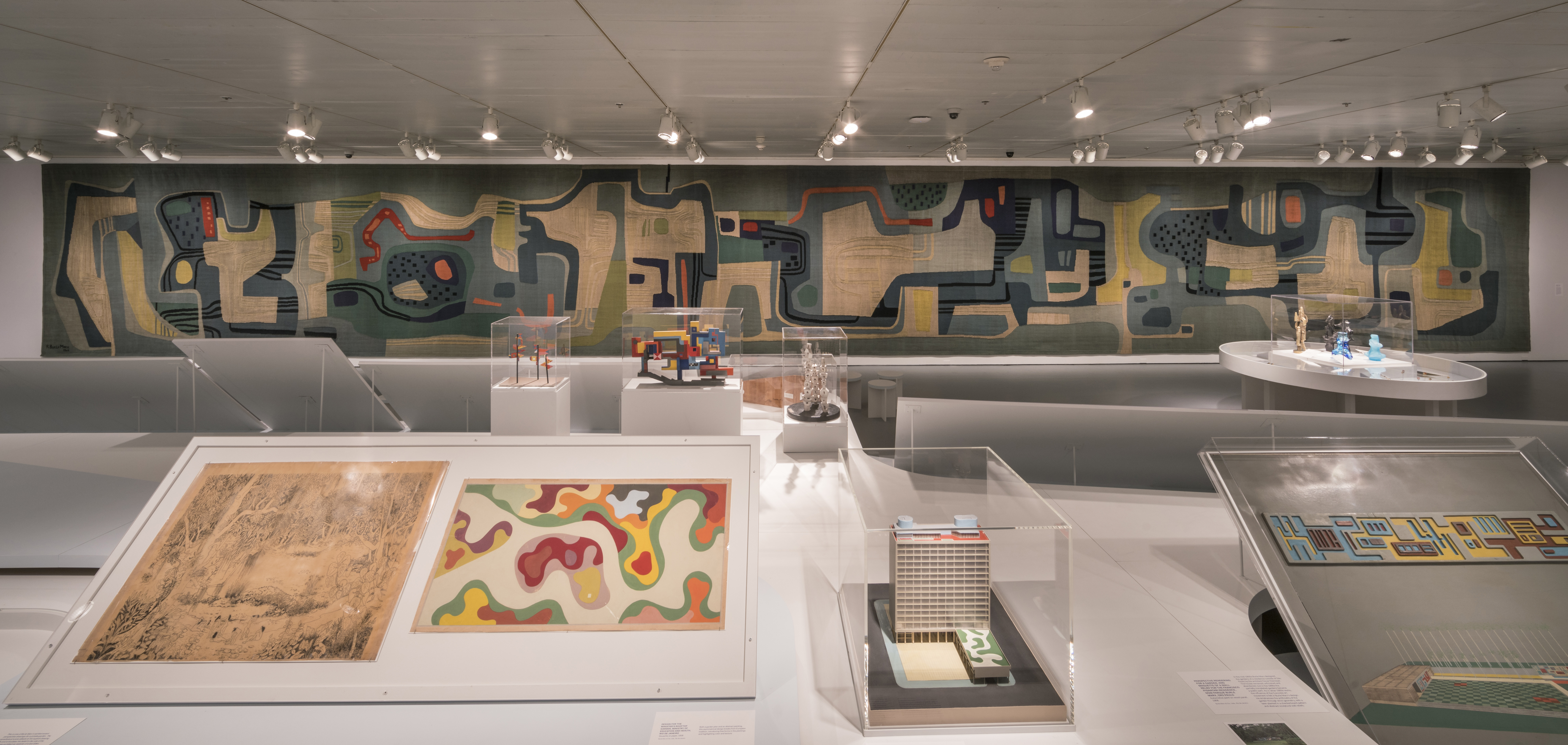
Yet this exhibition misses the opportunity to impart upon the visitor not only the astonishing breadth of Burle Marx’s diverse artistic production but also his incredibly important cultural and political contributions to the modernist period in Brazil as well as his transformation of the practice of landscape architecture into a form of environmental advocacy.1 Throughout his professional career, Burle Marx developed and maintained close ties with those in political power, certainly a useful strategy for obtaining commissions. However, he also proved adept at leveraging those same connections in order to play a significant role in the greater project of cultural construction in a rapidly modernizing country, construing the Brazilian landscape as a significant element of cultural heritage. Burle Marx’s prescient advocacy for the conservation of the environment was effectively played out in two distinct realms: design and writing. His talent for writing, in the form of environmentalist rhetoric, was most effectively leveraged during Brazil’s twenty-one-year military dictatorship that began in 1964.
One might ponder why the Jewish Museum chose to host this exhibition. Yes, Burle Marx’s father Wilhelm Marx was a German-Jewish emigrant to Brazil, but his four sons and two daughters were raised Catholic by their devout Dutch emigrant mother, Cecília Burle. Yes, the exhibition presents Burle Marx’s late projects for the courtyard and the stained-glass windows of the Beit Yaakov Synagogue in Guarujá, Brazil, commissions gained through his professional connections with the family-run Safra Bank. But so much of the Jewish experience is about a search for identity by a historically marginalized group, and arguably Burle Marx’s strength is that of an observer from the margins. Burle Marx and his contemporaries, who are silently present in the exhibition, indeed explored the notion of developing a particularly modern Brazilian identity from the 1930s onward. And it is perhaps this search that anchors his work more convincingly at the Jewish Museum than the examples of his design work for synagogues.
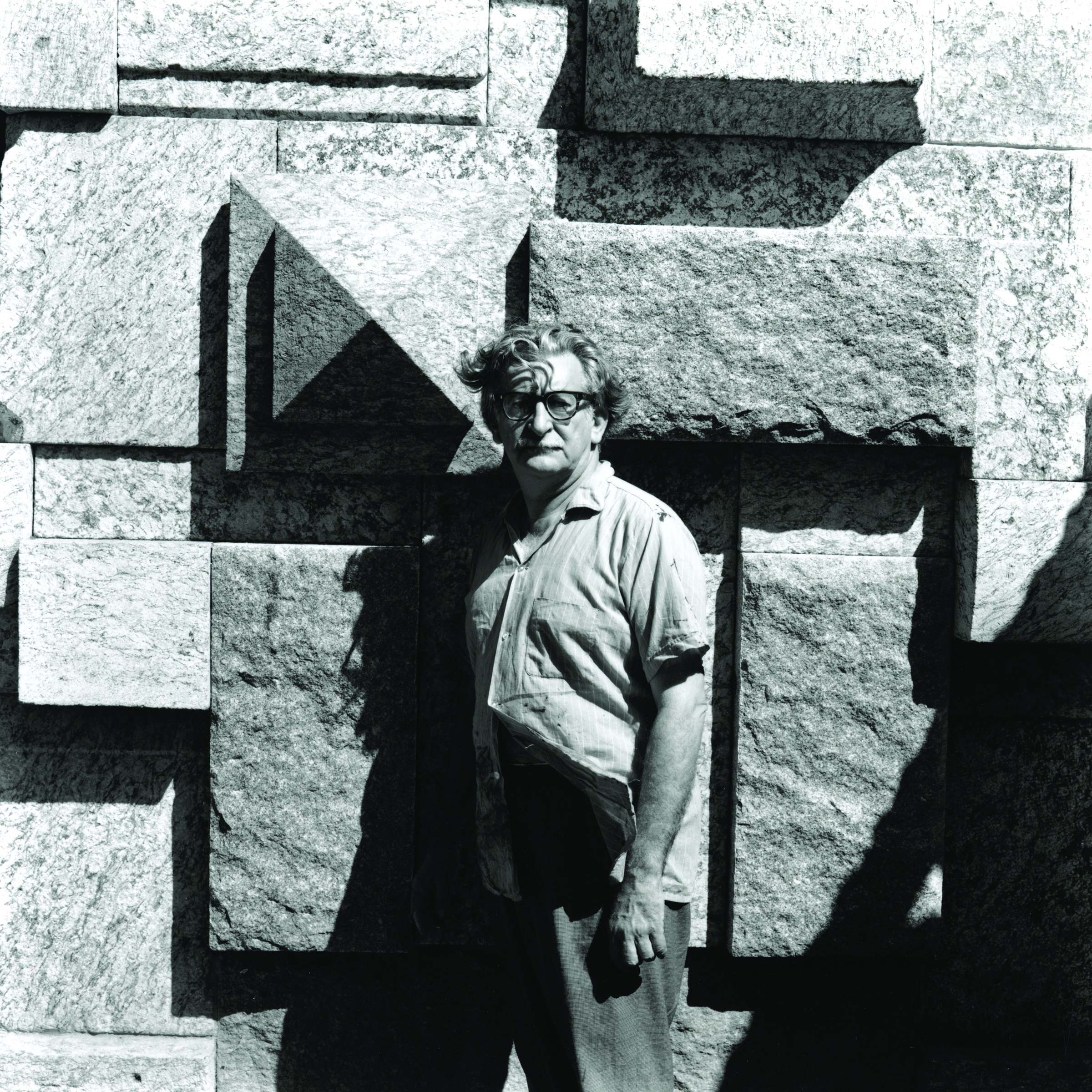
Roberto Burle Marx (1909–1994) came of age in the 1930s, a period of significant political transformation in Brazil. Gétulio Vargas, the country’s longest-serving president, entered as a technocratic revolutionary leader in 1930, and was elected president in 1934. His presidency evolved into the Estado Novo (New State) dictatorship by 1937, a regime focused on nationalism and industrialization, and lasted until 1945. Following on the heels of the vanguard Semana de Arte Moderna (Modern Art Week), held in 1922 in São Paulo and led by the painter Emiliano di Cavalcanti and the poet Mário de Andrade, the Vargas regime also focused on developing a new international image of modernity in Brazil, often expressed through radically new architecture. The careers of Lúcio Costa and Oscar Niemeyer (and shortly thereafter, that of Burle Marx) sprang from this vision, first with the project for the new headquarters of the Ministry of Education and Health in Rio de Janeiro (1937–1942) and followed by the Brazilian Pavilion for the 1939 New York World’s Fair at Flushing Meadows, Queens. Vargas, specifically through his creation of the new Ministry of Education, not only sought to project this image of Brazilian modernity onto the international stage but also embraced the notion that architecture could be mobilized to support this construct, drawing from the International Style while transforming it through what he hoped would be seen as a particularly Brazilian lens.
Burle Marx’s landscape career was launched with the support of Lúcio Costa, whom he knew as a family neighbor in Rio de Janeiro and as a professor at the Escola Nacional de Belas Artes where Burle Marx was studying painting. Costa recommended him for the position of the director of the Department of Parks and Gardens in Recife, the capital city of the northeastern Brazilian state of Pernambuco. At the age of just 25, Burle Marx found himself immersed in the rich intellectual milieu of Recife’s elite, working with the radically progressive administration of Governor Carlos de Lima Cavalcanti. Several of the works in the Jewish Museum’s exhibition are drawn from this formative period, including three particularly stunning perspectival ink drawings of two of his public plaza renovations in Recife. It is with the design of these plazas that Burle Marx first began to examine the idea of the “ecological garden,” creating a tropical tableaux with plants selected from specific regions of Brazil and the equatorial belt. The gardens of the Praça de Casa Forte (1935) deploy aquatic plants from the Amazon and the Nile within three reflecting pools, while the Praça Euclides da Cunha (1934) presents typical plants, including cacti, of the “caatinga” desert forest of the interior of the state of Bahia. The plaza celebrates the life of Brazilian author da Cunha’s great novel, Os Sertões, translated as The Devil in the Backlands. In both plazas, it is the narrative power of these tropical plantings that serves to express the idea of brasilidade, or “Brazilian-ness.” From this very early moment in his career, Burle Marx explored the role of ecology, and specifically a celebration of the biodiversity within Brazil, as a key element of Brazilian modernity. The development of this theme of ecological narrative throughout his professional career is one of his greatest contributions—not only to Brazil’s modern architecture but to the very conception of landscape architecture.
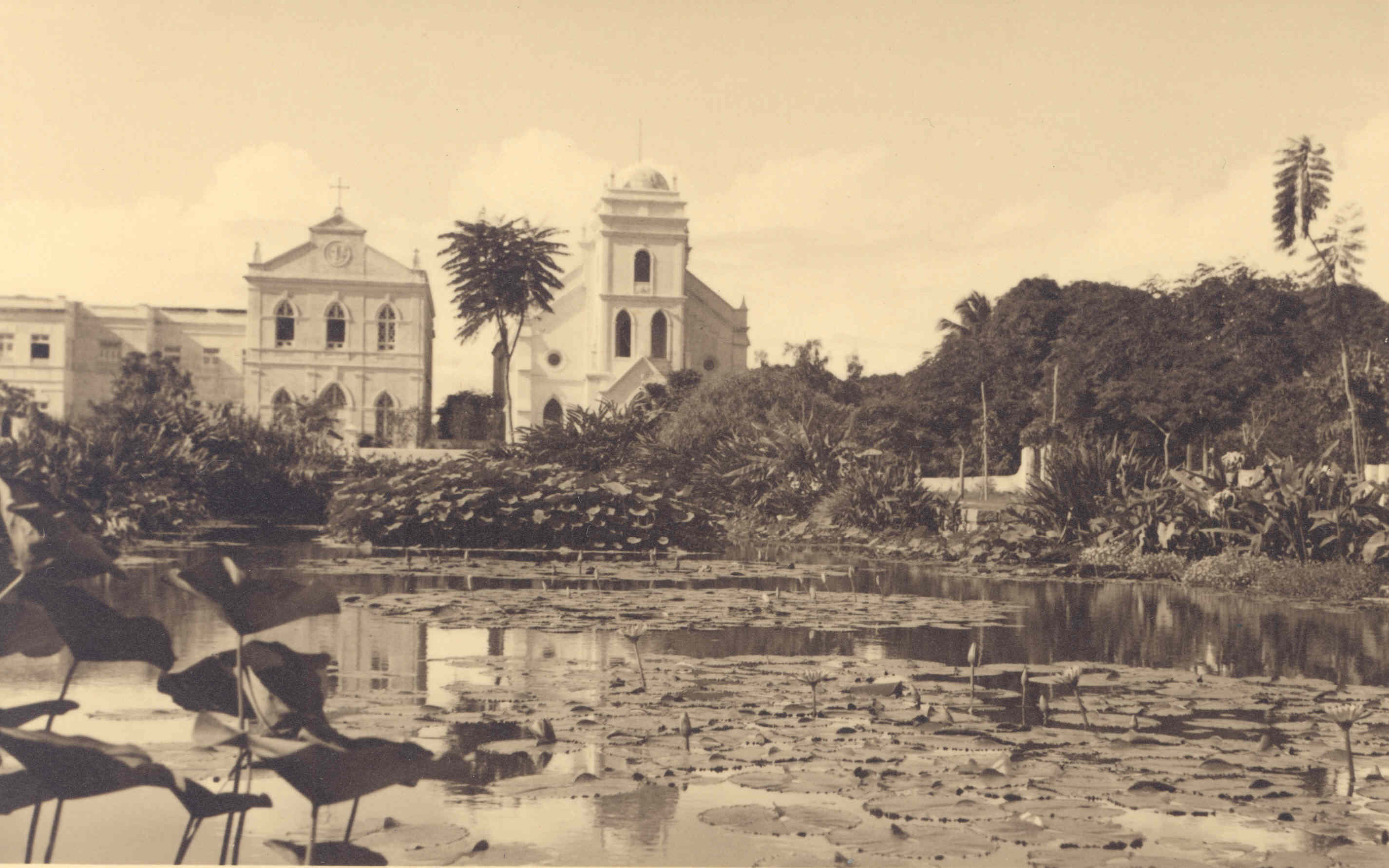
Returning to Rio de Janeiro after the rise of the Estado Novo and the ouster of Pernambuco’s governor due to his suspected communist leanings, Burle Marx entered late into the design process for the new headquarters building for the Ministry of Education and Health, a touchstone building of Brazilian modern architecture. Le Corbusier had been called to Brazil in 1936 by Vargas’s Minister of Education, Gustavo Capanema, and the team of architects gathered by Costa set to work, eventually jettisoning Le Corbusier’s bar scheme along the waterfront of Guanabara Bay for an L-shaped configuration on a square site in the newly flattened Castelo district in downtown Rio. Burle Marx began working with the team in 1937, developing designs for the ground-level public plaza, the minister’s large private roof terrace on the projecting two-story exhibition gallery slab, and a simple roof garden for the restaurant at the top of the tower slab. It is Burle Marx’s fantastic and colorful amoeboid gouache plan of the minister’s roof terrace that greets visitors entering the Jewish Museum’s exhibition. These sinuous, kidney-shaped forms and bright, flat colors have become synonymous with Burle Marx’s work, though, of course, the range of his formal vocabulary is quite broad, including the particularly geometric formalism that pervades his later work.
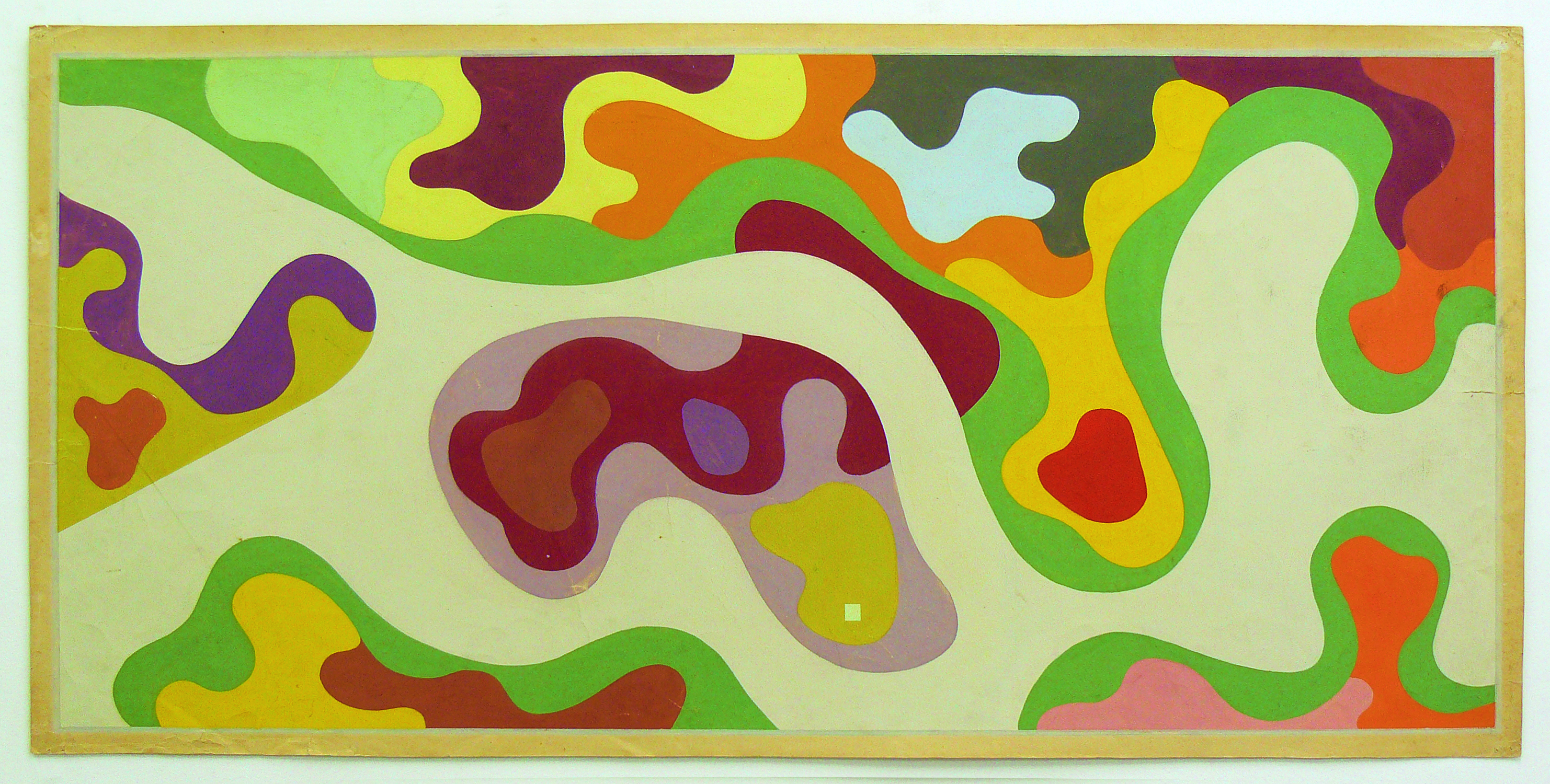
Yet Burle Marx’s amoeboid shapes, often noted as evocative of Juan Arp, appear often in the nineteenth-century gardens and plazas of Brazil. The use of these sinuous forms juxtaposed with the rectilinear geometries of buildings and palaces is a signature feature of the French landscape designer Auguste François-Marie Glaziou, who arrived in Rio de Janeiro in 1858 at the invitation of Brazilian Emperor Dom Pedro II to develop Rio’s parks and gardens. Glaziou’s public parks and imperial gardens, such as the Quinta da Boa Vista, the Campo de Santana, and the Passeio Público, include similar amoeboid ponds and native Brazilian plantings. Again, the Burle Marx plaza and terraces at the ministry function as narrative structures—they tell the story not only of Brazilian modernism but of the political and cultural embrace and reinterpretation of hundreds of years of European colonial presence in the country.2
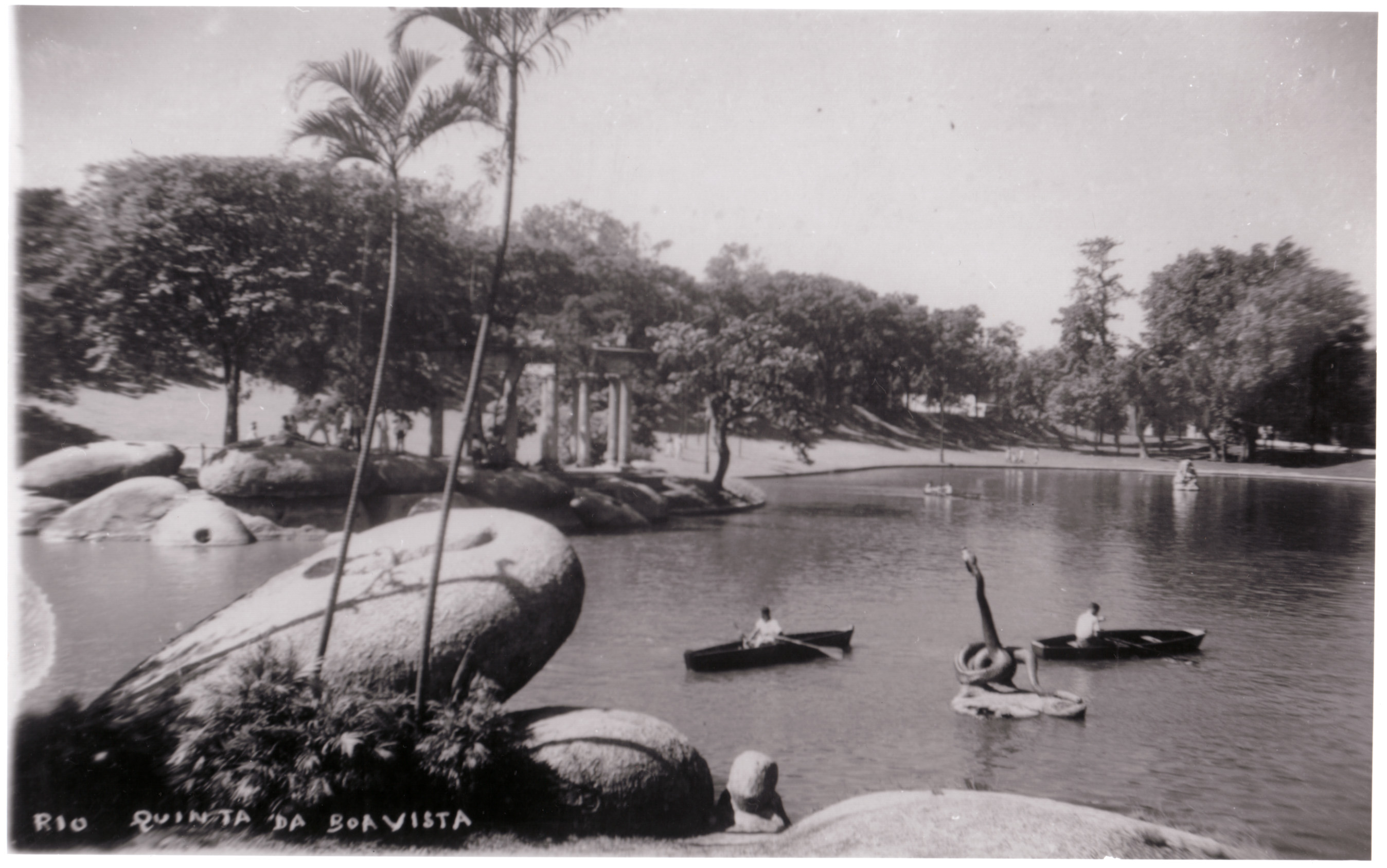
Costa continued to be a significant presence in Burle Marx’s trajectory as a landscape architect. An early proponent of the Instituto do Patrimônio Histórico and Artístico Nacional (the National Institute of Historic and Artistic Heritage, an early historic landmarks commission under the same jurisdiction as the Ministry of Education and Health for which the headquarters building was constructed), Costa sought to include modernist buildings on this official list of protected sites. In a 1951 letter to the minister advocating for the inclusion of the Ministry of Education and Health headquarters on the list of landmarked buildings, he writes of the significance of Burle Marx’s gardens as part of the complex. After describing the inventiveness of Brazilian structural engineers, Costa adds two additional key elements of success: climate and plant material, with “nature itself invited to be part of the plan,” specifically identifying the rich contribution of Burle Marx.3 Indeed, Burle Marx’s work is intrinsically linked to many examples of significant modernist architecture in Brazil, and the brilliance of these buildings is in large part due to their collaborative interplay with gardens. This interlaced relationship of the modernist garden with the new architecture of Brazil, while quietly present in the exhibition with works by Oscar Niemeyer, Affonso Eduardo Reidy, Rino Levi, and Olev Redig de Campos, is made significantly less explicit in than it might have been by the curators of the show.

Burle Marx’s introduction to the architect Oscar Niemeyer while working on the ministry gardens was the beginning of a significant collaboration lasting over a decade. In 1943, Niemeyer invited him to design the gardens for his new complex of buildings arrayed around an artificial lake at Pampulha, a municipality on the outskirts of Belo Horizonte, the capital of the state of Minas Gerais. The client was Juscelino Kubitschek, then mayor of Belo Horizonte, and soon-to-become governor of the state, with the political backing of Vargas. The buildings—a hotel, casino, yacht club, dance hall, and a chapel—embodied both the hedonism (and Catholicism) of the elite at that time as well as the emergent curvilinear Brazilian modernist style, arguably influenced by the colonial baroque. The lush surrounding gardens at Pampulha were splendid, with Burle Marx’s gouache plan for the hotel on display at the Jewish Museum. This was, however, the one building of the five not constructed. Kubitschek went on to become the president of Brazil in 1956, and with his sweeping campaign promise of “fifty years of progress in five,” he developed and built Brasília, the new centrally located capital.
Despite many statements to the contrary, Burle Marx did not participate in the planning or construction of Brasília during the Kubitschek presidency.4 Instead of collaborating with Niemeyer and Costa on this new capital, Burle Marx split, although he continued working on a few private gardens in Brazil, moving his office to oil-rich Caracas, Venezuela, in 1956. There, he completed the brilliant Parque del Este—first working with the military dictator Marcos Pérez Jiménez, to develop the landscape for an international exposition, but then finishing the project as a public park under the newly elected democratic president Rómulo Betancourt. The gouache plan for the Parque del Este, on view at the Jewish museum, is an exquisite example of Burle Marx’s public work at its finest and one of his first large public parks operating independently of architecture. This is a significant shift from his previous work, and viewers are left to speculate on what Burle Marx’s work at the urban scale for Brasília might have been.

Burle Marx returned to Brazil in the early 1960s, and under Carlos Lacerda’s governorship in Rio de Janeiro, he worked to reinvent the city after it lost its place to Brasília in 1961 as the capital of Brazil. His masterful work at the Parque do Flamengo, a landfill and parkway transformed into a gorgeous public garden, was completed just as the democratic presidency was ousted by a military coup with help from the United States. The new military regime would last from 1964 until 1985, with the most oppressive dictatorial years and human rights abuses occurring between 1967 and 1979.
Many cultural and political figures were harassed, exiled, or otherwise driven from Brazil in a form of self-imposed exile during the dictatorship, including Niemeyer, Gilberto Gil, Caetano Veloso, and Chico Buarque. Burle Marx, however, remained in the country, accepting a 1966 appointment from President Castelo Branco to the Conselho Federal de Cultura (Federal Council of Culture).5 Despite the ethical complexity of working with the military regime, Burle Marx considered this consular appointment as an important cultural project, providing a platform from which to develop his ideas of the modern Brazilian landscape, its protection, and its relationship to the public realm—all wrought through a modernist approach to aesthetics, ecology, and conservation—even in a milieu in which critical speech acts were highly restricted.
Burle Marx reveals, through a series of eighteen carefully crafted depositions presented to the Council from 1966 to 1974, that another talent of this “Brazilian modernist” was his rhetoric. This critically important aspect of his oeuvre is not captured by the Jewish Museum’s exhibition. Burle Marx was a messenger, an early advocate for the environment, and this is one of his greatest and most powerful acts as a landscape architect, a role that today’s practitioners are still striving to fill. As counselor, he argued for the designation of more national parks and natural reserves, for the conservation of cultural landscapes in the historic colonial towns of the interior, for the protection of the Botanical Gardens of Rio de Janeiro and its adjacent forest nursery, and for a more robust enforcement of the Brazilian Forestry Code that would protect the country’s forests from exploitative deforestation. Burle Marx—perhaps at some personal risk, considering several implicit critiques of the regime’s values that are present in his depositions—leveraged his position as counselor to argue for environmental protection from a government consumed with the modernist desire for desenvolvimento, development.
Interestingly, it may very well be Burle Marx’s participation in the regime as counselor that finally earned him his eventual commissions in Brasília in the late 1960s and early 1970s, again in collaboration with Oscar Niemeyer: the Ministry of Foreign Relations (Palácio do Itamaraty), the Ministry of Justice (Palácio da Justiça), and the extraordinary 30-acre triangular plaza now known as the Praça das Cristais, whose gouache planting plan is on view at the Jewish Museum. The Praça das Cristais was designed for the very Ministry of the Army that controlled the regime, facing Niemeyer’s monumental Quartel-General do Exército. On the eve of the inauguration of this building in 1968, Niemeyer, frustrated by his harassment by the regime, fled to France.
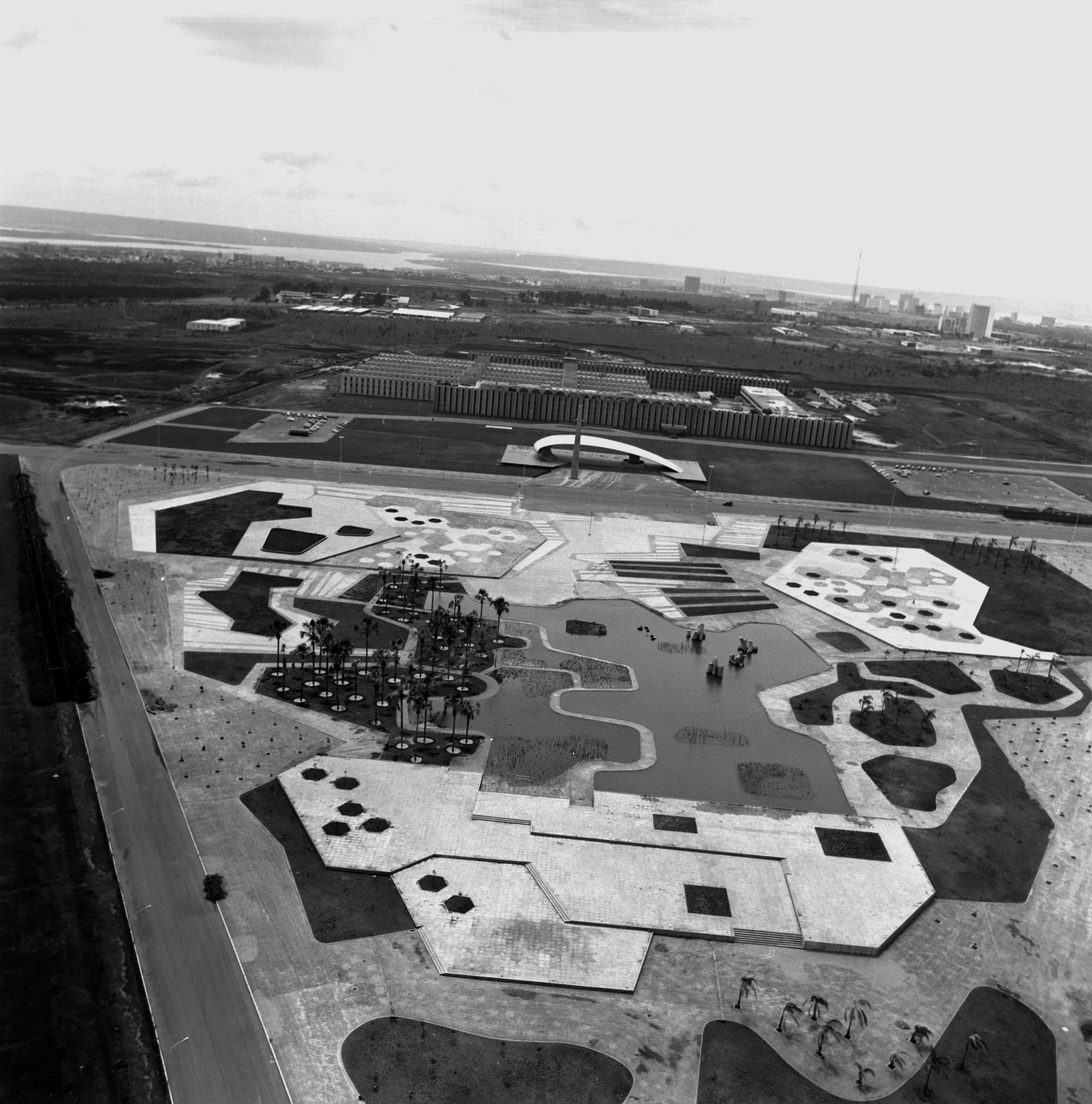
Yet the curators do include works that tacitly open up other readings of Burle Marx’s oeuvre. A side gallery off the main exhibition space displays an unusual etching attributed to Burle Marx, part of the collection borrowed from the Sítio Roberto Burle Marx, his home, studio, and 40-acre experimental garden on the outskirts of Rio de Janeiro. Described as a “protest” drawing, it is inscribed with the words “fora Ludwig,” a message opposing the American Daniel Ludwig’s 1967 purchase and deforestation of a massive 1.6 million acres of the Amazon rain forest, the Jari Project, for paper production. It is a striking piece and also a reminder of the role that the United States played in the deforestation of the Amazon as well as its collusion with Brazil’s military regime.
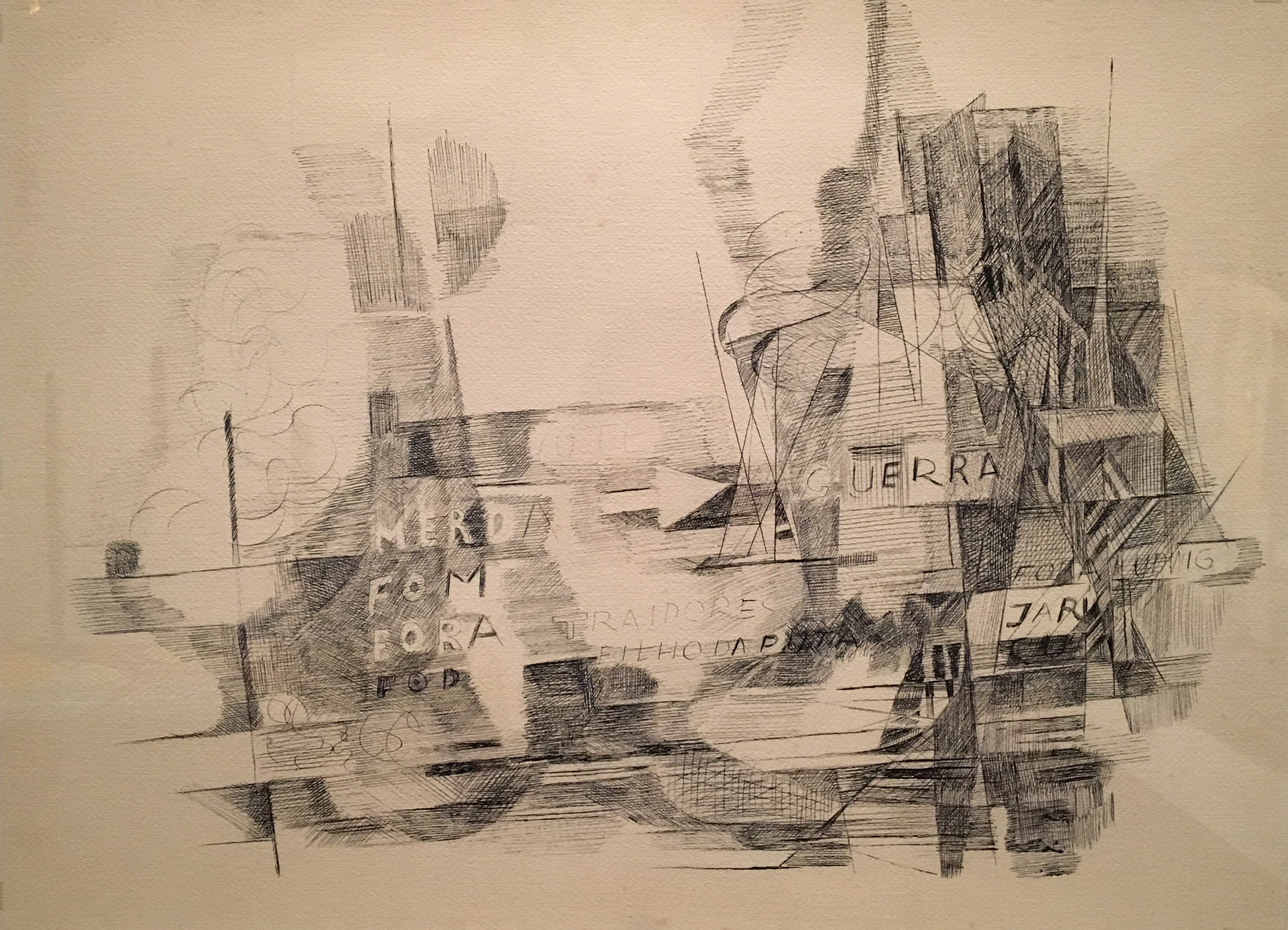
The Jewish Museum curators chose to include seven artists born after 1950 as part of the exhibition, commissioning work from them in response to the influence of Burle Marx on their own artistic production. It is a strange trope and has produced somewhat uneven results that are interspersed with Burle Marx’s own work throughout the gallery. One contributor did stand out in his choice of words, or rather, sounds. Arto Lindsay, the American musician and composer who splits his time between New York and Rio de Janeiro, produced a soundtrack for the exhibition blending acoustic guitar, electronic musical patterns, and field recordings of natural sounds that drift through the air of the galleries. In the catalog for the exhibition, published by Yale University Press, the curator Jens Hoffmann interviews each of the artists, and a selection of their work is presented in a few spreads. In his interview, Lindsay states insightfully, “In Brazil, where the presence of nature is exuberant to the point of being overbearing, Burle Marx explored the juxtaposition of designed, restrained nature with nature left unchecked.”6 Lindsay chose not to visualize his musical composition on his catalog spreads but rather to include several images of the Brazilian artist Hélio Oiticica’s Parangolés. This is a fascinating choice: Oiticica (1937–1980) is a much more interesting respondent to Burle Marx’s work than any of the others selected for this exhibition, albeit not a contemporary artist of today but a younger contemporary of Burle Marx.
Oiticica’s costume parangolés, like Burle Marx’s gardens, play out in space and time. He designed around thirty of these tent-like costumes and capes, some of them stenciled with texts, between 1964 and 1968. The word parangolé is carioca Rio slang, alternately meaning “idleness, unexpectedness, or agitation.”7 Note the resonance of these colorful draped costumes with the gouache sketches of costumes designed by Burle Marx in 1954 for Igor Stravinsky’s ballet Petrushka—particularly the caped charlatan, on display at the Jewish Museum. Burle Marx intended his gardens to provide didactic environments for the public, to expose them to the wealth and beauty of Brazilian flora. Oiticica headed to the samba schools in the marginalized fringes and favelas of Rio, designing these costumes for his friends in Mangueira, moving well beyond the small circles of the Brazilian elite. Like Burle Marx, Oiticica understood movement and time but also questions of access, marginality, and the crisis of identity. Like Burle Marx, he expected viewers to engage physically with his work and was a master of color. Parangolés were meant to be worn and danced in, and his penetrables, brightly colored planar outdoor sculptural installations, similarly invited interaction. Burle Marx felt strongly about the role of sculpture in the park—decrying military heroes on horses, he preferred abstract geometric totems, colored tile surfaces, or bas-relief panels of his own design to act as counterpoints to his garden’s planted surfaces. Oiticica, as well, is politically complicated—he accepted a military government-sponsored traveling grant to work as an artist in New York City. And though his work was resistant and provocative to the regime, it was grudgingly accepted along with that of other Tropicália artists for a brief period.
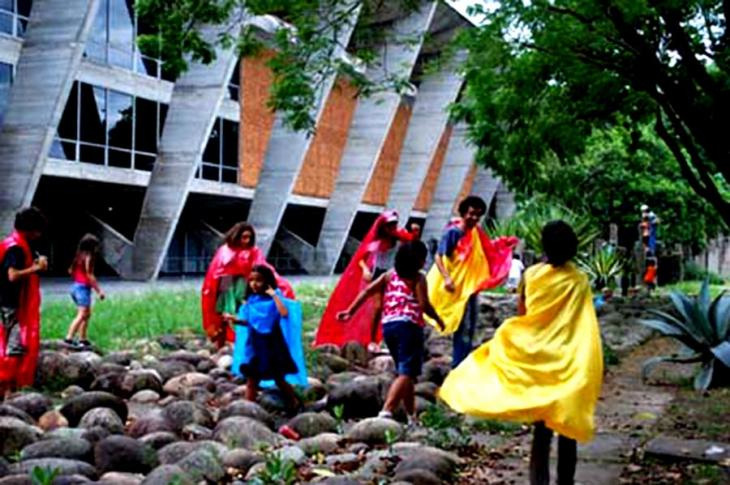
Burle Marx, the counselor, sought to reconcile the world of the environment with that of the encroaching realities of a new and rapidly urbanizing Brazil, one with a massive housing crisis, with extreme income inequalities, with the desire of the marginalized multitudes to relax into dance and carnival and soccer, to scrape the landscape and settle informally on the granite hills of Rio. These realities were often at odds with his advocacy of conservation. And what of Burle Marx’s decision to work with the military regime in Brazil? Ethically fraught, indeed, though also common to many political contexts, and certainly inextricable from the international collusion of countries like the United States with that regime. As Oiticica famously stenciled on a parangolé flag, “Seja marginal, seja herói.” To be marginal is to be a hero.
-
This argument, and much of the research that follows, is drawn from Seavitt Nordenson’s forthcoming book with the University of Texas Press, examining Roberto Burle Marx’s didactic public parks as well as his role as a cultural advisor to the military regime in Brazil from 1966–1974. ↩
-
The selection of plant material in many Brazilian gardens has quite a tropical colonial backstory. A later unbuilt scheme by Burle Marx for the Ministry of Education and Health plaza dating from 1944 included an amoeba-shaped pond with Victoria amazonica lily pads and a double allée of royal palm trees—two species that were embraced by Burle Marx and the modernists as indicators of the Brazilian-ness of the landscape. This is despite the fact that these giant lily pads were first discovered in British Guiana, not Brazil, and named “regia” to honor the Queen of England, and that the royal palms in Brazil are not native but descendants of the original palma mater of Rio’s Jardim Botânico, an 1809 gift from the Island of Mauritius to Dom João VI, the Portuguese Prince Regent of Brazil and founder of the botanical garden in 1808. ↩
-
This early adoption of protective landmark status for modernist buildings and landscapes is a prescient aspect of IPHAN’s work, which also protected a significant number of Brazil’s baroque colonial buildings. Costa’s letter was republished in English for the Atlantic in 1956. See Lúcio Costa, “Testimony of a Carioca Architect: Concrete, Sun, and Vegetation,” in the Atlantic (February 1956): 137–139. ↩
-
Lúcio Costa, who won the competition for the master plan of Brasília, sought to include Burle Marx as a member of the team with Oscar Niemeyer, the architect of the capital’s buildings, but Burle Marx refused to sign the contract. Historical record is patchy, but it seems, according to Grady Clay, the longtime magazine editor of Landscape Architecture, along with documents in the Costa archives, that there was a falling out between Kubitschek and Burle Marx regarding payment for his work at Pampulha. And there may have been a political rift between Niemeyer and Burle Marx shortly afterward, involving his work for the unbuilt ornamental gardens at the Parque do Ibirapuera in São Paulo (1954). ↩
-
As counselor, Burle Marx served as one of twenty-four well-known figures of the Brazilian cultural elite, including the sociologist Gilberto Freyre and the writers João Guimarães Rosa and Rachel de Queiroz. He stepped down from the council in 1974. ↩
-
See Jens Hoffmann and Claudia J. Nahson, Roberto Burle Marx: Brazilian Modernist (New York: The Jewish Museum / New York and London: Yale University Press, 2016): 186. ↩
-
For more on the politics of parangolés, see Anna Dezeuze, “Tactile Dematerialization, Sensory Politics: Hélio Oiticica’s Parangolés,” in Art Journal, vol. 63, no. 2 (Summer 2004): 58–71. ↩
Catherine Seavitt Nordenson is an associate professor of landscape architecture at the City College of New York and principal of Catherine Seavitt Studio. Her research explores novel landscape restoration practices given the dynamics and politics of climate change. She is interested in the intersections of political power, environmental activism, and design, particularly as manifest in both public landscapes and the written word.

